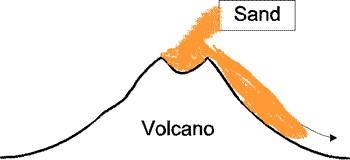BACKGROUND:
Many hazards are associated with volcanic eruptions.
In this lab, students will consider the following dangers:
Volcanic ash = small particles of the magma that are
blown out of the volcano. They are carried away by the wind, along with
volcanic gases. They land on the Earth’s surface, creating layers that may
be several feet in thickness. This may cause buildings to collapse.
Volcanic gases = gases emitted by a volcano either
alone or along with ash or lava. Volcanic gases consist chiefly of water
vapor, carbon dioxide, carbon monoxide, and various compounds of sulfur,
chlorine, and other elements. None of these are breathable!
Ash flows = streams of hot ash and rock fragments that
are mixed with hot air and other gasses. Together these form a fluid which
rapidly flows down the side of a volcano.
Lava flow = a "river" of lava that moves
downhill and can crush, burn, and bury structures
Mud flow = a mass of water-saturated rock debris that
moves downslope as a fluid. Previously deposited ash often makes up part of
a mudflow.
Landslide = a downhill flow of rock debris on the side
of a volcano
Volcanoes erupt differently, depending on the
composition and thickness of the erupting lava, the amount of gas in the
parent magma, and force of the eruption. Volcanoes that erupt lava that is
low in silica and gases tend to be "quiet," mostly pouring out
streams of fairly fluid lava. Kilaeua volcano in Hawaii is a good example.
Volcanoes that erupt silica-rich magmas, and that have a lot of gas, tend to
be explosive. This produces tremendous clouds of volcanic ash, ash flows,
and gasses. The loose material produced by these eruptions often becomes the
raw material for landslides or mudflows.
Mt. St. Helens, Mt. Etna, and Kilauea are active
volcanoes. Mt. Vesuvius and Mt. Lassen are sleeping (dormant) volcanoes;
they erupted at some point in the past (1912 for Mt. Lassen, 1944 for Mt.
Vesuvius). They were dangerous in the past, and will probably erupt and be
dangerous again in the future.
PROCEDURE:
- Show the students the slides from the volcanoes set. Use these slides
to illustrate the kinds of damage that volcanoes can produce. Emphasize
that lava flows, ash flows, mud flows, etc. can all occur. As you look
at the slides, ask your students what damage was caused by the
eruptions, or what might happen in future eruptions. Tell students to
record the "dangers" they see on their lab sheets.
 In
the second part of the lab, students create their own volcanic disaster
and record what happens. They will need the volcano that they made for
PLATE TECTONICS -VOLCANOES (3) LAB. Have the students make a village
near the volcano. Instruct them to use sand to represent an ash flow.
Tell them to gently pour sand until the "cone" becomes
unstable and flows down the side of the model, as shown below. Ask the
students to keep track of the amount of sand they use. They should
realize that it takes a lot of "lava" or "ash" to
create a flow. Make sure the students also note students that there is a
"critical point" at which the sand begins to slide and then
moves very quickly. We suggest that you do this activity either in a tub
or on newspaper that can capture the sand in order to reuse it.
In
the second part of the lab, students create their own volcanic disaster
and record what happens. They will need the volcano that they made for
PLATE TECTONICS -VOLCANOES (3) LAB. Have the students make a village
near the volcano. Instruct them to use sand to represent an ash flow.
Tell them to gently pour sand until the "cone" becomes
unstable and flows down the side of the model, as shown below. Ask the
students to keep track of the amount of sand they use. They should
realize that it takes a lot of "lava" or "ash" to
create a flow. Make sure the students also note students that there is a
"critical point" at which the sand begins to slide and then
moves very quickly. We suggest that you do this activity either in a tub
or on newspaper that can capture the sand in order to reuse it.
This exercise helps the students to see that an ash flow will bury
everything in its path. They should record their observations by drawing
a "before" and "after" picture.
ANSWERS:
Exercise 1:
Mt. St. Helens - lava flows, landslides, ash flows, mudflows, ash, and
gasses.
Mt. Vesuvius. - similar to Mt. St. Helens
Mt. Etna - lava flows, gasses
Mt. Lassen - similar to Mt. St. Helens
Kilaeua - lava flows